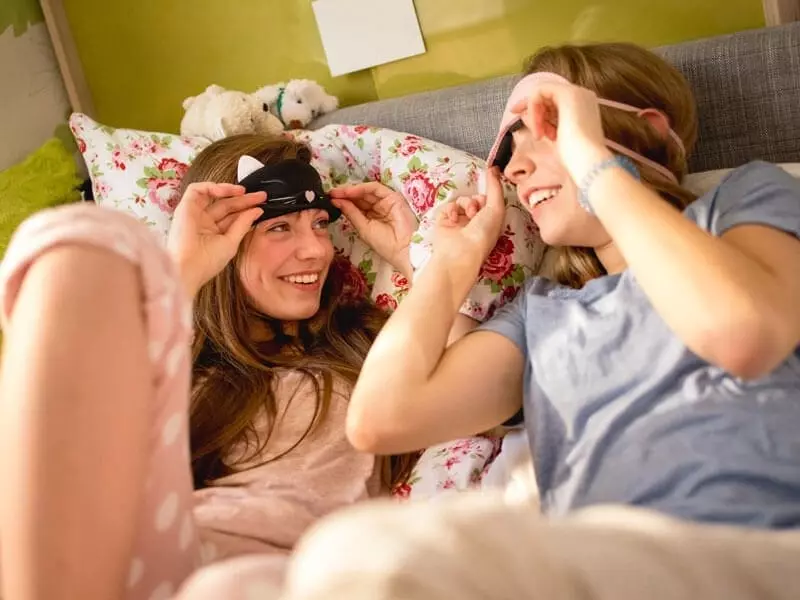Have your heard of the mythical character the Sandman? Legend has is that the Sandman drops fine grains on children’s eyes as they fall asleep. The sand prevents the eyes from reopening until morning so the children will remain in dreamland.
This magical man first appeared in a story by Hans Christian Andersen, where he was kind and told beautiful stories to kids as they slept. This nice version has made recent appearances in films like “Rise of the Guardians” and “The Santa Clause 2.” Other depictions of the Sandman are crueler and give him sinister motives.
Although you know the Sandman doesn’t exist, you might wish he would pay you a visit on nights when you struggle to fall asleep. Or, you may jokingly blame him for the goop you find in the corners of your eye every morning. But even without visits from the Sandman, your eyes have quite an interesting nightlife. Discover three facts about your eyes and sleep below.
1. Your Eyes Go Through a Carwash Every Night
Since the Sandman didn’t sprinkle sleep sand on your eyes, how did that goop get there? It accumulates as a result of your eyelids and tears combining to become a carwash for your eyes.
When you close your eyes for a long night’s rest, they stay firmly closed. Your tears wash over your eyes as they move around during different sleep phases. The tears pick up dust, old eye cells, mucus, bacteria, and any other small foreign substances in your eye. The closed eyelids guide the goop that ends up in the corners of your eye near your nose and along your lash lines.
The same cleaning process happens throughout the day when you blink. However, during those hours, the goop doesn’t get a chance to accumulate, so you don’t notice any gunk.
Typically, eye goop, which is properly called rheum, isn’t a sign of any eye condition. You can simply remove it with a warm, damp washcloth. But if you notice changes in your rheum, you may have an eye infection such as pink eye. Pay attention to rheum with an unusual color or consistency, and take note if your eyes produce more rheum than usual. Visit All About Eyes to rule out an infection if you experience these symptoms.
2. Blue Light Makes Your Eyes Want to Pull an All-Nighter
With the rise of smartphones and streaming video services, people spend many more hours a day interacting with electronics. And if you use your few precious hours before sleep relaxing in front of these devices, your sleep could be the victim.
Normally, our eyes use the light around us to figure out what time of day it is and cue our brains whether we should prepare for sleep. Light with wavelengths from the blue portion of the spectrum keeps us alert. Optimally, at night less blue light meets our field of vision so our brain begins releasing melatonin, a hormone that regulates our sleep cycle.
But devices with screens emit large amounts of blue light, as do LED lights. The cells in your eyes sense those wavelengths of light and pass on the message to the brain, disrupting the scheduled release of melatonin.
So far, there isn’t strong evidence that the blue light from smart devices does damage to your eyes. The sun itself can cause more harm. Still, sleep deprivation is linked to numerous health conditions, such as anxiety, depression, heart problems, weight gain, and type 2 diabetes.
If you want to avoid blue-light-induced sleep problems, try these tricks:
- Avoid devices that give off blue light at least 90 minutes before you hit the sack.
- Try apps or software that reduce the amount of blue light your devices give off.
- Uses glasses with lenses that block out blue light if you must use devices before bedtime.
Also, remember that blue light may only be part of the problem. Often the activity you engage in on your TV or smart device keeps your mind active, which can make falling asleep more difficult. Give yourself 30 minutes or so to clear your brain before bed so it can enter sleep mode.
3. Your Eyes Make Movies When You Dream
R.E.M. isn’t just an ’80s rock band—it’s also an acronym for what your eyes do while you dream. They make rapid eye movements. REM is one of several sleep stages, and it’s during this phase that our most vivid dreaming happens. Even if you don’t remember your dreams the next morning, your brain always dreams during REM sleep.
In recent years, scientists have discovered some fascinating facts about REM sleep. For example, they’ve learned that each eye movement creates a new image in your mind. Think of these as cells in a film strip or snapshots on your camera. Your eyes become the camera that pans around your dream world to take in the scenery.
Next time you prepare for a visit from the Sandman, remember that your eyes have a huge impact on your quality of sleep. Make some adjustments to how you treat your eyes if sleep has become elusive recently. And to keep your eyes in good condition no matter your sleep patterns, make an appointment at All About Eyes.

